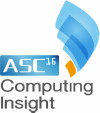 Although the teams in the ASC16 Asia Student Supercomputer Challenge are all using the same Inspur-provided gear, there’s a LOT of variety in what they built. Cluster sizes in this competition range from three to twelve nodes, with anywhere from zero to eight accelerators.
Although the teams in the ASC16 Asia Student Supercomputer Challenge are all using the same Inspur-provided gear, there’s a LOT of variety in what they built. Cluster sizes in this competition range from three to twelve nodes, with anywhere from zero to eight accelerators.
Let’s meet the teams who believe that smaller is better when it comes to cluster competitions.
Hong Kong Baptist University is a team of newbies who are getting their first taste of HPC and the brutal world of student cluster competitions. In the video, we chat with our new best buddy Freeman about the origins of his English name – it’s from the movie Braveheart, so I had to scream “Freedom, freedom!” and “Hold!” several times; I just couldn’t control myself.
This is the first competition for both Freeman and also the university. It’s also the first time these kids have had the opportunity to deal with a real cluster, even though it’s on the small side with only four nodes. However, it packs quite a punch with eight NIVIDA K80 GPUs. The team ended up running three nodes with 6 K80s due to some problems in getting MPI configured properly.
Nanyang Technological University: We didn’t get a chance to interview the Nanyang team. They were too busy getting their system together and fighting fires (figuratively, not literally) to speak with us. But we can tell you that this is their second or third time competing at the ASC and that this group is fairly experienced. They look to be another team chasing the LINPACK crown, running a four-node system with 512 GB memory and eight NVIDIA K80 GPUs.
Zhejiang University: Everything is going smoothly for Team Zhejiang in this first interview. The only thing out of the ordinary is the hideously loud fan noise coming from their rack. This made me curious, since everyone is running the same gear. Why are Zhejiang’s fans so much louder? I get the answer to this question later on, so there’s a cliff hanger for you.
Speaking of their system, they’re sporting a four-node cluster with eight NVIDIA K80 GPUs. They’re aiming for LINPACK, admittedly, and were worried if anyone had a P100 (which I mistakenly called a P1000) in the competition. No one has a P100, and they probably won’t make their way into a student competition until sometime next year.
We also take a look at the massive pile of snack food in front of their booth – way more than I’ve seen at any of the other 16 booths. The reason for that remains a mystery.
Boston Green is the only American team in the competition. It’s a partnership between universities in the Boston area. The team on the ground in China are all from Boston University, but team members back in the states include students from Northeastern University and MIT.
The team is running a six-node cluster, with six Intel Phi co-processors. In the video, they’re in the midst of figuring out how to use Infiniband – a technology they’re seeing for the first time today. The student we’re talking to, Sean, is in charge of the DNN application; he notes that there are some differences between clusters he’s worked on and the largest computer in the world, Tianhe-2.
Northwestern Polytechnical University: Aided by our trusty translator Kensey, we interviewed a representative of NW Polytechnical University. We found that the team was having problems with the power cap while running eight nodes with eight NVIDIA K80 accelerators – hitting 4,000 watts, which is a lot more than the 3,000 watt power cap.
They tried throttling down their nodes, but that still didn’t get them under the cap. They ended up cutting their node count to six, with six accelerators, which is what they ran during the competition.
Next up we’ll take a look at the teams running mid-sized clusters ranging from seven to nine nodes. Stay tuned…
Posted In: Latest News, ASC 2016 Wuhan
Tagged: supercomputing, HPC, Boston University, Asia Student Supercomputer Challenge, Northeastern University, Zhejiang University, Nanyang Technological University, MIT, ASC16, Northwestern Polytechnical University, Hong Kong Baptist University, ASC 2016
